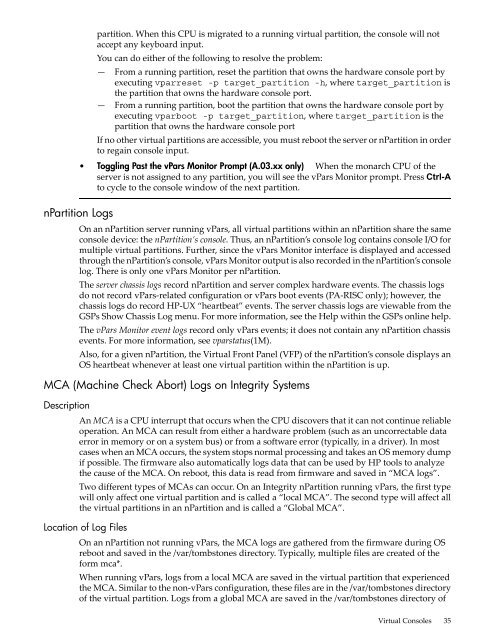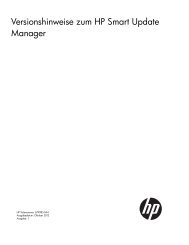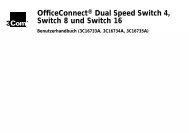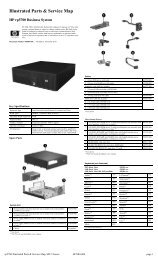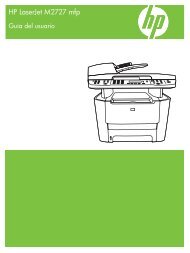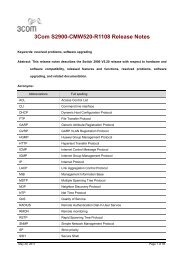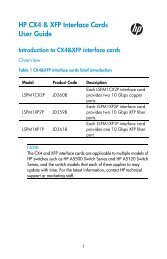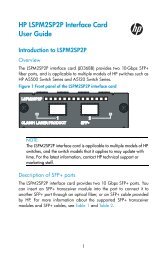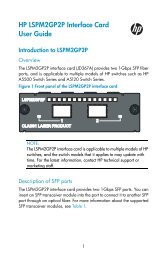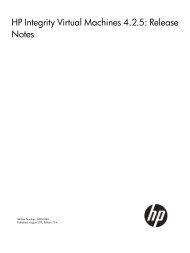HP-UX Virtual Partitions Administrator Guide - Hewlett Packard
HP-UX Virtual Partitions Administrator Guide - Hewlett Packard
HP-UX Virtual Partitions Administrator Guide - Hewlett Packard
You also want an ePaper? Increase the reach of your titles
YUMPU automatically turns print PDFs into web optimized ePapers that Google loves.
nPartition Logs<br />
partition. When this CPU is migrated to a running virtual partition, the console will not<br />
accept any keyboard input.<br />
You can do either of the following to resolve the problem:<br />
— From a running partition, reset the partition that owns the hardware console port by<br />
executing vparreset -p target_partition -h, where target_partition is<br />
the partition that owns the hardware console port.<br />
— From a running partition, boot the partition that owns the hardware console port by<br />
executing vparboot -p target_partition, where target_partition is the<br />
partition that owns the hardware console port<br />
If no other virtual partitions are accessible, you must reboot the server or nPartition in order<br />
to regain console input.<br />
• Toggling Past the vPars Monitor Prompt (A.03.xx only) When the monarch CPU of the<br />
server is not assigned to any partition, you will see the vPars Monitor prompt. Press Ctrl-A<br />
to cycle to the console window of the next partition.<br />
On an nPartition server running vPars, all virtual partitions within an nPartition share the same<br />
console device: the nPartition’s console. Thus, an nPartition’s console log contains console I/O for<br />
multiple virtual partitions. Further, since the vPars Monitor interface is displayed and accessed<br />
through the nPartition’s console, vPars Monitor output is also recorded in the nPartition’s console<br />
log. There is only one vPars Monitor per nPartition.<br />
The server chassis logs record nPartition and server complex hardware events. The chassis logs<br />
do not record vPars-related configuration or vPars boot events (PA-RISC only); however, the<br />
chassis logs do record <strong>HP</strong>-<strong>UX</strong> “heartbeat” events. The server chassis logs are viewable from the<br />
GSPs Show Chassis Log menu. For more information, see the Help within the GSPs online help.<br />
The vPars Monitor event logs record only vPars events; it does not contain any nPartition chassis<br />
events. For more information, see vparstatus(1M).<br />
Also, for a given nPartition, the <strong>Virtual</strong> Front Panel (VFP) of the nPartition’s console displays an<br />
OS heartbeat whenever at least one virtual partition within the nPartition is up.<br />
MCA (Machine Check Abort) Logs on Integrity Systems<br />
Description<br />
An MCA is a CPU interrupt that occurs when the CPU discovers that it can not continue reliable<br />
operation. An MCA can result from either a hardware problem (such as an uncorrectable data<br />
error in memory or on a system bus) or from a software error (typically, in a driver). In most<br />
cases when an MCA occurs, the system stops normal processing and takes an OS memory dump<br />
if possible. The firmware also automatically logs data that can be used by <strong>HP</strong> tools to analyze<br />
the cause of the MCA. On reboot, this data is read from firmware and saved in “MCA logs”.<br />
Two different types of MCAs can occur. On an Integrity nPartition running vPars, the first type<br />
will only affect one virtual partition and is called a “local MCA”. The second type will affect all<br />
the virtual partitions in an nPartition and is called a “Global MCA”.<br />
Location of Log Files<br />
On an nPartition not running vPars, the MCA logs are gathered from the firmware during OS<br />
reboot and saved in the /var/tombstones directory. Typically, multiple files are created of the<br />
form mca*.<br />
When running vPars, logs from a local MCA are saved in the virtual partition that experienced<br />
the MCA. Similar to the non-vPars configuration, these files are in the /var/tombstones directory<br />
of the virtual partition. Logs from a global MCA are saved in the /var/tombstones directory of<br />
<strong>Virtual</strong> Consoles 35


